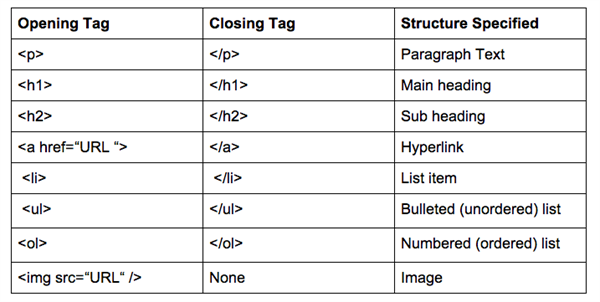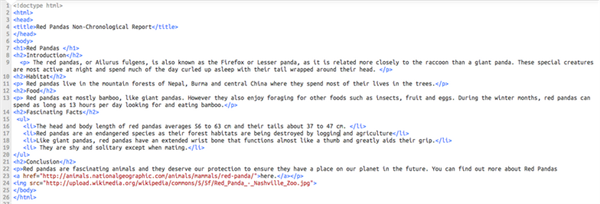What is HTML?
HTML stands for Hyper Text Markup Language. It’s not a programming language but one used to write web pages. It was developed and introduced by British computer scientist Sir Tim Berners-Lee in 1991. It uses pairs of tags to structure a page, ‘telling’ web browsers how it should be displayed (although the actual appearance of the page – fonts, colours, etc – is controlled by style sheets). Tags are not themselves displayed but you can right-click on a web page and select “view source” to inspect the HTML.

Common tags used in HTML.
HTML is a good means to get pupils working in a formal, text-based computer language. As with other such languages, it helps reinforce the importance of spelling, punctuation and grammar: mistakes in the mark-up of the page usually become quite apparent in the way the browser displays the page.

Screenshot of HTML code.
<!DOCTYPE> is the first element in an HTML document. It tells the web browser what version of HTML the page is written in It’s an instruction to the web browser rather than an HTML tag as such.
The first tag in an HTML document is the <html> tag, telling the web browser that this is an HTML document.
The <head> tag contains the <title> tag and any other elements that the writer wishes to be included within the head of the document – for example meta tags, which provide to search engines information about the document.
<title> tells the web browser the title of the document. This is important because the title is shown in search-engine results, is displayed in the web browser’s toolbar and gives a name to the page when it is added to your favourites list.
<body> is where the contents of an HTML page are stored and where text, images, lists, hyperlinks, etc are added, again using pairs of tags. Notice that the <body> tags are nested inside the <html> tags, so the closing </body> tag comes before the </html> tag at the end of the document.
Why is HTML important?
HTML is one of the foundation technologies of the World Wide Web. Without HTML, your web browser would have no information on how to structure the content of the web page you are accessing or how any of the information should appear. HTML tags indicate which parts of a web page are images, text or video, as well as identifying where links to other web pages are located. Given the importance of HTML, it is constantly undergoing revisions as it evolves to meet the demands of the World Wide Web. There have been six revisions since its introduction in 1991, with the current version being HTML5. HTML can also be used when creating email templates, formatting posts within forums and blogs, and embedding sections of one website into another.